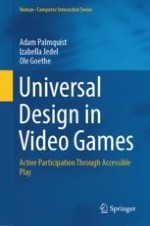2024 | OriginalPaper | Buchkapitel
9. Universal Design in Exergames
verfasst von : Adam Palmquist, Izabella Jedel, Ole Goethe
Erschienen in: Universal Design in Video Games
Aktivieren Sie unsere intelligente Suche, um passende Fachinhalte oder Patente zu finden.
Wählen Sie Textabschnitte aus um mit Künstlicher Intelligenz passenden Patente zu finden. powered by
Markieren Sie Textabschnitte, um KI-gestützt weitere passende Inhalte zu finden. powered by
